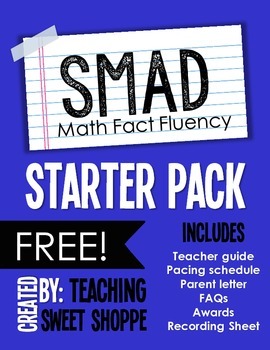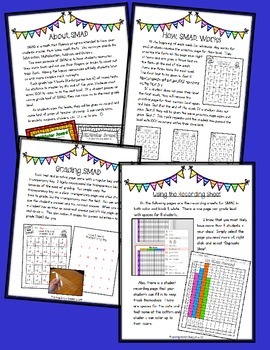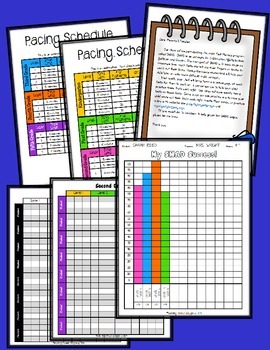Teaching Sweet Shoppe
3.9k Followers
Grade Levels
K - 5th
Subjects
Resource Type
Standards
CCSSK.CC.A.3
CCSSK.OA.A.1
CCSSK.OA.A.5
CCSS1.OA.C.5
CCSS1.OA.C.6
Formats Included
- Zip
Pages
35 pages
Teaching Sweet Shoppe
3.9k Followers
Description
Be sure to download the preview file to see examples of what's included!
SMAD is a math fact fluency program intended to have your students master their basic math facts. The acronym stands for Subtraction, Multiplication, Addition, and Division.
The main purpose of SMAD is to have students memorize their math facts and not use their fingers or tricks to count out their facts. Having the basics memorized will help students later on with more complex math concepts.
Each grade has 4 levels (Kindergarten has 6) of timed tests for students to master by the end of the year. Students must score 100% to move on to the next level. If a student passes an entire grade level of SMAD, they can move on to the next grade level.
In this starter pack you will receive:
* Teacher’s Guide
* Pacing Schedule
* Parent Letter
* FAQs
* Awards
* Recording Sheet
Get SMAD Kindergarten Level Here!
Get SMAD for FIRST GRADE Here!
SMAD is a math fact fluency program intended to have your students master their basic math facts. The acronym stands for Subtraction, Multiplication, Addition, and Division.
The main purpose of SMAD is to have students memorize their math facts and not use their fingers or tricks to count out their facts. Having the basics memorized will help students later on with more complex math concepts.
Each grade has 4 levels (Kindergarten has 6) of timed tests for students to master by the end of the year. Students must score 100% to move on to the next level. If a student passes an entire grade level of SMAD, they can move on to the next grade level.
In this starter pack you will receive:
* Teacher’s Guide
* Pacing Schedule
* Parent Letter
* FAQs
* Awards
* Recording Sheet
Get SMAD Kindergarten Level Here!
Get SMAD for FIRST GRADE Here!
Total Pages
35 pages
Answer Key
N/A
Teaching Duration
1 Year
Report this resource to TPT
Reported resources will be reviewed by our team. Report this resource to let us know if this resource violates TPT’s content guidelines.
Standards
to see state-specific standards (only available in the US).
CCSSK.CC.A.3
Write numbers from 0 to 20. Represent a number of objects with a written numeral 0-20 (with 0 representing a count of no objects).
CCSSK.OA.A.1
Represent addition and subtraction with objects, fingers, mental images, drawings, sounds (e.g., claps), acting out situations, verbal explanations, expressions, or equations.
CCSSK.OA.A.5
Fluently add and subtract within 5.
CCSS1.OA.C.5
Relate counting to addition and subtraction (e.g., by counting on 2 to add 2).
CCSS1.OA.C.6
Add and subtract within 20, demonstrating fluency for addition and subtraction within 10. Use strategies such as counting on; making ten (e.g., 8 + 6 = 8 + 2 + 4 = 10 + 4 = 14); decomposing a number leading to a ten (e.g., 13 - 4 = 13 - 3 - 1 = 10 - 1 = 9); using the relationship between addition and subtraction (e.g., knowing that 8 + 4 = 12, one knows 12 - 8 = 4); and creating equivalent but easier or known sums (e.g., adding 6 + 7 by creating the known equivalent 6 + 6 + 1 = 12 + 1 = 13).





